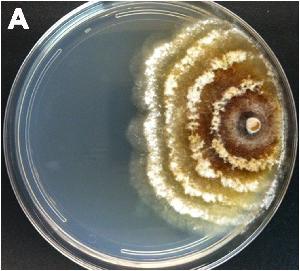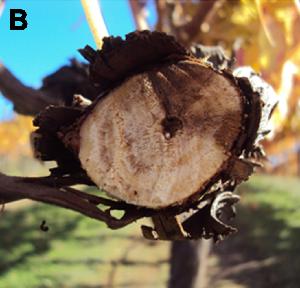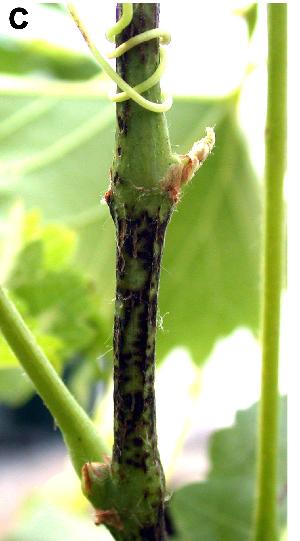
Photo credit: Daniel Lawrence

Photo credit: Renaud Travadon

Photo credit: Mizuho Nita
The genome of Diaporthe ampelina (Berk. & M.A. Curtis) was sequenced by the Department of Viticulture and Enology at University of California Davis (http://cantulab.github.com). The genome sequence and gene predictions were downloaded from NCBI on Sept 24, 2015. Please note that this copy of the genome is not maintained by NCBI and is therefore not automatically updated. JGI tools were used to add functional annotation to the gene models.
In grapevines D. ampelina causes two different
diseases, Phomopsis cane & leaf spot and Phomopsis dieback. The
latter is characterized by V- or irregular-shaped wood cankers in
canes, spurs, cordons and/or trunk as well as general canopy
symptoms of shoot dieback and dead spurs. During the development of
Phomopsis cane and leaf spot, D. ampelina directly attacks
all green tissues of the vine, causing necrotic lesions on the
leaves, green stems, and fruit. The sequenced isolate (UCDDA912)
was recovered from diseased grapevine wood in the upper trunk of a
“ Seeded Thompson” vine sampled in the USDA-ARS
National Germplasm Repository grapevine collection located in
Winters, Solano Co., California, in May 2011.
NCBI WGS accession number: LCUC00000000
Genome Reference(s)
Morales-Cruz A, Amrine KC, Blanco-Ulate B, Lawrence DP, Travadon R, Rolshausen PE, Baumgartner K, Cantu D
Distinctive expansion of gene families associated with plant cell wall degradation, secondary metabolism, and nutrient uptake in the genomes of grapevine trunk pathogens.
BMC Genomics. 2015 Jun 19;16(1):469. doi: 10.1186/s12864-015-1624-z
